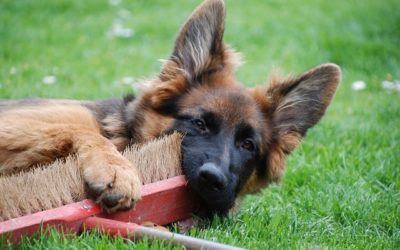Should you brush your dog’s teeth? The vast majority of dog owners don’t seem to pay attention to this part of your dog’s grooming. According to BARK*, over 70% of dog parents have never brushed their dogs’ teeth.
Are you among them?
Since you’re here chances are that you’ve never held a dog toothbrush to clean your German shepherd’s teeth and you’re considering making a switch. But why should you do it and what’s the best way to go about it?
Find out the answers to all your dog teeth brushing concerns below.
Why Brush Your Dog’s Teeth?
Think about it – when you eat, at least a few food particles remain stuck between your teeth. The longer these food remains stay in your mouth the more likely they are to cause dental problems. So you have to keep removing them by brushing – either after every meal or a few times throughout the day.
That’s the case with your dog too. If you’re not cleaning his teeth on the regular, you’re setting the stage for trouble in the near future. Here’s a brief look at the problems your dog’s likely to encounter.
1. Bad breath
This isn’t much of your dog’s problem since we all know too well that you’re the one who’ll have to put with it.
And that’s the more reason you should get those teeth brushed.
2. Dental problems
These include the usual problems you can find in people such as tooth decay, periodontal disease, and general inflammations in the mouth. These make up a huge chunk of all the (ailments) that affect dogs.
Periodontal disease, for instance, affects a whopping 87% of dogs over the age of three according to the Royal Veterinary College.
All the dental problems here can be attributed to tartar which is basically hardened plaque. The tartar usually accumulates below and above your dog’s gum line, setting off a chain of events that lead to the aforementioned dental problems.
Brushing your dog’s teeth can help keep away these problems. So it’s really important for your pooch. On the other hand, it can save you a substantial amount in the long run.
Because once your dog catches any of these diseases, rest assured you’re visiting a vet. And can set you back as much as $700 – or even more – depending on where you live or the severity of your dog’s situation.
With that out of the way, it’s time for the biggest concern among dog owners:

Keep your dog’s teeth clean and healthy.
How To Brush Your Dog’s Teeth
Brushing your dog’s teeth seems like a lot of work. And it can be exactly that if you aren’t sure how to go about it. What do you need and what’s the best way to do it?
Brushing Your Dog’s Teeth – What You Need
Here what your toolset should comprise of if you’re looking to keep your dog’s teeth clean:
1. A dog toothbrush
Using a regular toothbrush might seem reasonable enough but it actually is a bad idea. Our toothbrushes are way too large. They also have stiffer bristles that are sure to injure your dog’s tender gums. Plus, their design doesn’t allow a thorough job.
Here are a few dog toothbrush types you’re likely to meet out there:
- Finger Toothbrushes
These are designed to be won on the finger as you can guess from the name and are made entirely of rubber. They don’t have bristles but small nubs instead that help scrape food particles and plaque from between your dog’s teeth.Finger toothbrushes generally offer more control with the movements so they’re definitely much more ideal for thorough teeth cleaning. Besides cleaning, you can also massage your dog’s gums, which improves circulation.
H&H Dog Finger Toothbrush is one of the best in the market right now.
It’s available on Amazon HERE in value packs of 4 or 8 and is a great option for your dogs dental hygiene:
- Dual-Head Dog Toothbrushes
These typically have two bristled ends. One head is wider and longer compared to the other. This large head is usually intended to clean larger dentitions.
The small head, on the other hand, is intended for equally small teeth.
The Pet Republique dual head pack is great since it comes not with one but six toothbrushes.
- Multi-head Dog Toothbrushes Multi-head toothbrushes come with several – up to three – bristle heads either on one side. This arrangement allows you to brush the inside, outside, and top surfaces of the tooth simultaneously.
- Angled Dog Toothbrushes By far the most common dog toothbrushes you’ll find out there. They’re like your regular human toothbrushes but the heads are angled for easy access to your canine’s teeth.
As mentioned, this allows for a much more thorough cleaning job as compared to using a human toothbrush.
2. Dog toothpaste
Just like the case with toothbrushes, the temptation to use human toothpaste can also be strong. But don’t fall for it.
Human toothpaste ingredients are harmful to dogs. And since your pooch is naturally going to swallow the toothpaste, it’s best to avoid using it.
Xylitol, for instance, is quite popular with many brands and is thought to prevent tooth decay in people. But in dogs, this seemingly useful addition is toxic.
That’s why you have to stick to dog toothpaste for your hound’s oral hygiene.
Plus, the taste of human toothpaste is not very agreeable to dogs so chances are your canine is going to hate the teeth-brushing sessions. That’s the last thing you want.
You can grab the Petsmile Professional Dog Toothpaste since it’s a vet recommended toothpaste and approved by the Veterinary Oral Health Council.
You can also formulate your own home-made dog toothpaste by mixing coconut oil, turmeric, kelp, and dried parsley flakes.
Just warm a cup of coconut oil over a hot water bath and add ½ teaspoon of turmeric, ½ teaspoon of kelp, 1/8 tablespoon of dried parsley flakes and mix thoroughly.
Remember to store in a fridge between uses.
In addition to a toothbrush and toothpaste, be sure to have some treats with you as part of your dog teeth brushing toolset.
Use a doggy specific toothpaste – approved by vets and approved by the Veterinary Oral Health Council – Buy on Amazon
Brushing Your Dog’s Teeth – Steps
Having their mouth stuffed is not something most – if not all – dogs fancy. So you have to ease into it step by step. And that calls for patience.
Here’s what you need to do:
- Choose a calm time and place – your brushing time should be when the dog is calm and relaxed. Also, the place should be comfortable for you and your dog, ideally free from distractions and well-lit.
- Get into the right position – kneeling in front of or sitting beside your dog are some of the best options to go with. If your dog is small enough, you can put him in your lap facing away.
- Get your dog used to having his mouth opened – try holding your dog’s mouth open for a few seconds and then releasing it. Ideally, you want to mimic the various hand positions you’ll be using during brushing. Be sure to give him a treat every time you try something new.
- Touch the gums with your fingers – after your dog is comfortable with his muzzle and mouth being handled, try touching his gums with just your finger. Run your finger along his gum, mimicking a tooth brushing motion. Give him a treat when you’re done and keep trying until he’s comfortable.
- Introduce the toothbrush – no, it’s not yet time to start brushing. Remember your dog is used to your finger not anything else. In this step, you’re just letting him have a look – read sniff – the toothbrush so that he isn’t spooked out when you start using it on him. When you’re done, try touching the toothbrush to his teeth. Don’t forget the treats or lots of praise for when you’re done.
- Introduce the toothpaste – apply a small amount of toothpaste on your finger and let the dog lick it off. This will allow it to get used to both the taste and texture of the toothpaste. You might have to try out different options if your dog doesn’t like the paste. Multi-flavored toothpastes like Virbac C.E.T Enzymatic Toothpaste are best-suited for picky dogs.
- Start brushing – Apply a small amount of toothpaste on the toothbrush and start brushing. Hold up the upper lip and start with the front teeth, working in circular motions for about 30 or so seconds. You can move on to the back teeth and lower jaw if your dog is cooperative. Otherwise, aim to get your dog used to this by brushing just a few teeth per day as you work your way to more teeth. Don’t forget to have treats on hand.

How Often To Brush Your Dog’s Teeth
Dogs – like us – need their teeth brushed every day to scrape off the plaque before it hardens. Once a day will do just fine so it’s up to you to find the most ideal time, that is when your pooch is calm and you’re both free from distractions.
At What Age Should You Start Brushing Your Dog’s Teeth?
Dog teeth brushing can be introduced at any age. But puppies are naturally going to get used to it more easily compared to adult dogs. So if you have a pup this whole process is going to be easier.
That said, you don’t really need to start right away until he starts losing his puppy teeth. This usually happens between 4 and 6 months. This is the ideal age to introduce teeth brushing.

Get your puppy used to their teeth being brush at an early age. Gently introduce the brush to them… no need to use toothpaste right now. Simply get them familiar with it being part of their grooming.
Alternatives To Brushing Your Dog’s Teeth
Brushing your dog’s teeth is immensely beneficial but it’s not the only way to go about dental hygiene. Not all dogs are going to get comfortable with having their mouths stuffed with a toothbrush – especially if your dog is already an adult. Here are some alternatives that are just as helpful:
● Toys
Toys don’t just keep your dog’s spirits high. The bumps and grooves found on most them are great for riding your dog’s teeth of plaque during play. But not all dogs might appreciate chewing a toy.
● Dental Chews
Dog teeth cleaning chews are the best alternatives to teeth brushing. Unlike toys, most dogs will gladly jump on dental chews because of the ingredients.
● Bones
You’ll be hard-pressed to find a dog that doesn’t love a nice bone. And that makes bones some of the best alternatives to teeth brushing. They work pretty much like toys ensuring your furry friend’s teeth are plaque free.
● Coconut oil
Coconut oil works great in killing fungus and bacteria so it can serve your dog well in keeping those teeth clean. What’s more, it’s also quite flexible with how you can use it. You can apply it on the toothbrush (more like natural dog toothpaste), soak a bone in it, or mix it in your dog’s food. Just remember to let the bone dry when you soak it in coconut oil.
And that’s it about brushing your dog’s teeth. Starting can be a bit challenging but it gets easier as your dog gets used to it.
If it doesn’t, you can always employ other means to guarantee oral hygiene as you’ve seen above.
Happy brushing!
*Bark







